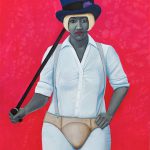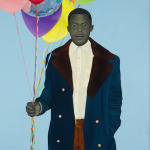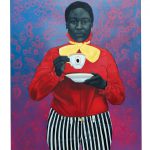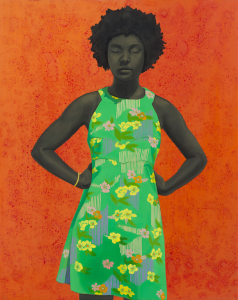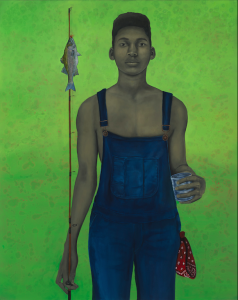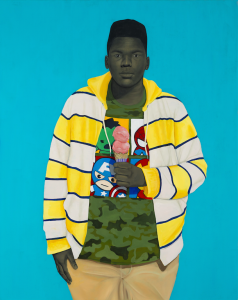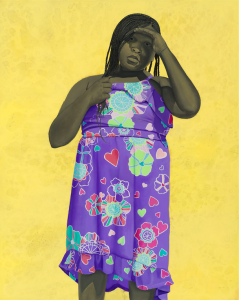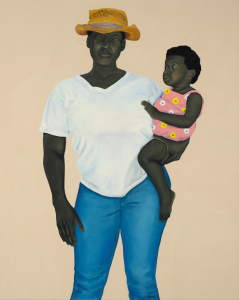- Madame Noire, 2011 Oil on canvas 54 x 43 inches Private collection, New York, NY Image courtesy of the artist and Monique Meloche Gallery, Chicago
- Pilgrimage of the Chameleon, 2016 Oil on canvas 71 x 51 inches Private collection, Guadalajara, Mexico Image courtesy of the artist and Monique Meloche Gallery, Chicago
- Grand Dame Queenie, 2013 Oil on canvas 54 x 43 inches Collection of Smithsonian’s National Museum of African American History and Culture, Washington, D.C. Image courtesy of the artist and Monique Meloche Gallery, Chicago
Making Mirrors: A Micro-Interview with Amy Sherald
by Elaine Sexton
Elaine Sexton: What led you to choose portraiture over other forms, given your interest in “staged narratives”? One can see, immediately, that your portraits are performances, not just a rendering of what you first see, but a true composition, embellished, engaged. Would you be willing to share the back-story of one of the portraits (shown here)? how you found the subject? what was it about the individual that led you to using a particular costume, or gesture, or employ some other stage direction?
Amy Sherald: As a child being an artist meant learning how to master drawing the human form which led me to portraiture. While looking at portrait after portrait in the process of learning art history, and noticing the absence of representations of people that looked like me within the art historical narrative, as a portrait painter, and a black person, that seemed like an obvious objective to tackle.
Portraiture has historically been, in my opinion, “staged narratives.” Like the custom of “self fashioning,” a term coined by literary and cultural historian, Stephen Greenblatt, referring to the act of constructing one’s identity, during the Renaissance, through “prescribed attire and behavior.” I was struck by what he said of the iconography of portraits, that, for example, they display “the gender-specific qualities prescribed .... through visual devices.”
I find my subjects randomly just living my everyday life. I can be in the grocery store or anywhere else, but when I see what I want I know it immediately. It’s funny because now my friends are starting to send me images of people who they think would make a “perfect Amy Sherald” painting, and usually they are right on. The person embodies the depth and weight of black history, along with an aesthetic of re-imagination or self-fashioning of that history.

Miss Everything (Unsuppressed Deliverance), 2014
Oil on canvas 54 x 43 inches
Private collection, Winston-Salem, North Carolina
Image courtesy of the artist and Monique Meloche Gallery, Chicago
In this case, that dress had polka dots, and I love polka dots. I loved that it was split in half with one side being completely blank. Almost representing two different people. I ran into Krystal and realized she was skinny enough to fit it. I had the dress for months before. I was having trouble painting that year because I was battling depression from my heart transplant and was very unmotivated. I needed to start something, paint something, so I asked her if she could come try it on for me in order to photograph her, and see if it would work. What happens when I see a person is instinctual not intellectual so maybe that is why I have a hard time answering, and tend to answer this question different every time I’m asked. When I see a person it’s the end product I see when I’m looking at them not them really. The portrait isn’t about them it’s about my vision and they are the vehicle to bring that to life, but if they were to stand next to the portrait after its done in my mind they exist as two different people.
When I first began to paint these portraits I was really interested in portraying a more fantastical narrative so costuming was a way for me to engage the idea of creating an alternate narrative extricated from the dominate historical narrative. Creating architypes break away from this an allow for a space of re-imagining.
ES: What a life-altering experience your heart transplant must have been, and still be. The reporter in me has to ask how this impacts your work, if it is possible to say.
AS: It didn’t affect my art directly, in that I received a transplant and all of a sudden needed to start painting about it. Expressing my emotional life through my work has never been my thing. That’s what diaries are for, at least for me. Now, my band width is much smaller, and I still struggle with not feeling like my old self, but I’m making it work – happy to be alive none-the-less, and always excited to experience each bonus year, and all the things that I wasn’t supposed to be here for, but am here now because of a family’s gift.
ES: All of your portraits are painted with the same grey pigment, your signature style, this instead of rendering a different skin tone for each these highly individuated characters. You have said that in doing so you are exploring the exclusion of the idea of color as race, that by removing “color” you are “portraying racialised bodies as objects.” Would you share your thoughts on this? How did this come about?
AS: In the beginning of trying to sift through the ideas of how I wanted to represent my portraits, black people, and our narratives I explored that idea. Now several years later when I consider it, it connects me to my inspiration, which is photography. Frederick Douglass, who is known to be the most photographed person of his time, sat for more portraits during the 1800s, more than even Abraham Lincoln. He did so wanting to ensure the accurate portrayal of black Americans. He had the unique opportunity, as a subject, to experience the discovery of photography. As both a critic and a subject, he discovered that photography had the ability to redefine the often stereotypical image and narrative of black Americans. The stillness of daguerreotypes, the beauty of black skin in black and white pictures, how everything came down to what the eyes were saying. And in those photographs they all are telling stories, from the youngest child to the oldest person. When I look at images from that period, in my mind, I stand simultaneously with them in their in deliberate gaze, and I understand and know that I am their future self, and dream.
ES: Your latest work in the exhibit, “A Wonderful Dream,” your first solo exhibit this year (2016) is less theatrical, but no less vivid than those portraits in the group show, “Look at Me Now!” (2015). Does a less satirical approach challenge stereotypes differently, perhaps more subtly?
AS: No, I don’t think it does. As time has progresses I have come to think of what I’m doing as an American painter in some ways is very similar to American Realism, which is painting the lives, and realities of everyday people. It’s not all about countering stereotypes, but it is also about making mirrors.
- The Make Believer (Monet’s Garden), 2016 Oil on canvas 54 x 43 inches Private collection, Chicago, Illinois Image courtesy of the artist and Monique Meloche Gallery, Chicago
- The Boy with the Big Fish, 2016 Oil on canvas 54 x 43 inches Private collection, Los Angeles, California Image courtesy of the artist and Monique Meloche Gallery, Chicago
- Innocent You, Innocent Me, 2016 Oil on canvas54 x 43 inches Private collection, Stockholm, Sweden Image courtesy of the artist and Monique Meloche Gallery, Chicago
- Pupa, 2016 Oil on canvas 54 x 43 inches Private collection, Winston-Salem, North Carolina Image courtesy of the artist and Monique Meloche Gallery, Chicago
- Mother and Child, 2016 Oil on canvas 54 x 43 inches Private collection, Chicago, Illinois Image courtesy of the artist and Monique Meloche Gallery, Chicago
Amy Sherald’s most recent honors include the 2016 Outwin Boochever Portrait Competition grand prize from the Smithsonian’s National Portrait Gallery, and exhibited her first solo exhibition in Chicago at moniquemeloche over the summer of 2016. Sherald lives in Baltimore and received her MFA in Painting from the Maryland Institute College of Art (2004), BA in Painting from Clark-Atlanta University (1997), and was a Spelman College International Artist-in-Residence in Portobelo, Panama (1997). She is a recipient of the Joan Mitchell Foundation Painting and Sculpture Grant (2014), a Pollock-Krasner Foundation Grant (2013). Her most recent solo exhibitions include Off The Chain: American Art Unfettered, 2nd Street Gallery, Charlottesville, VA (2015); Reginald F. Lewis Museum, Baltimore, MD (2013); and the Richard Demato Fine Arts, Sag Harbor, NY (2011). 2011 Residencies include Tong Xion Art Center, Beijing, China (2008) and Odd Nerdrum Private Study, Larvik, Norway (2005). Her work is in notable public collections, including the National Museum of Women in the Arts, the Smithsonian Museum of African American Art and Culture, and the United States Embassy, Dakar, Senegal. She is presented by Monique Meloche Gallery. For more information, please visit http://amysherald.com.

